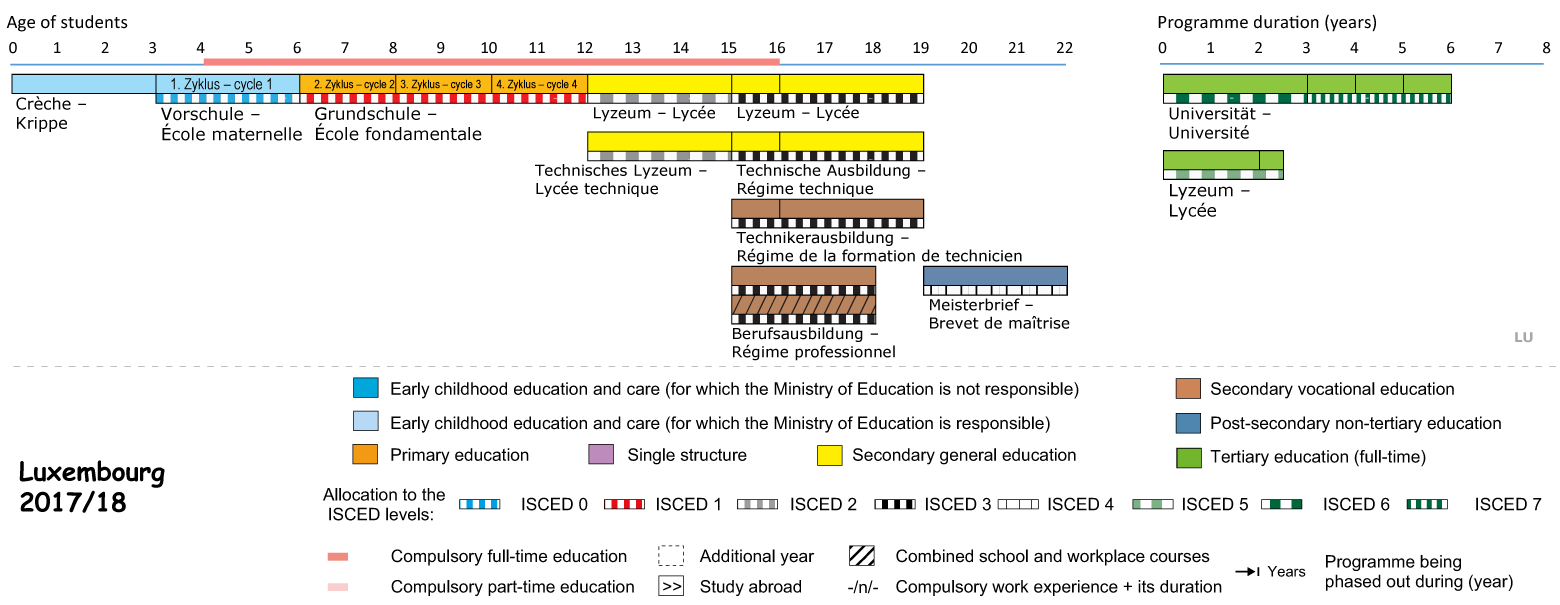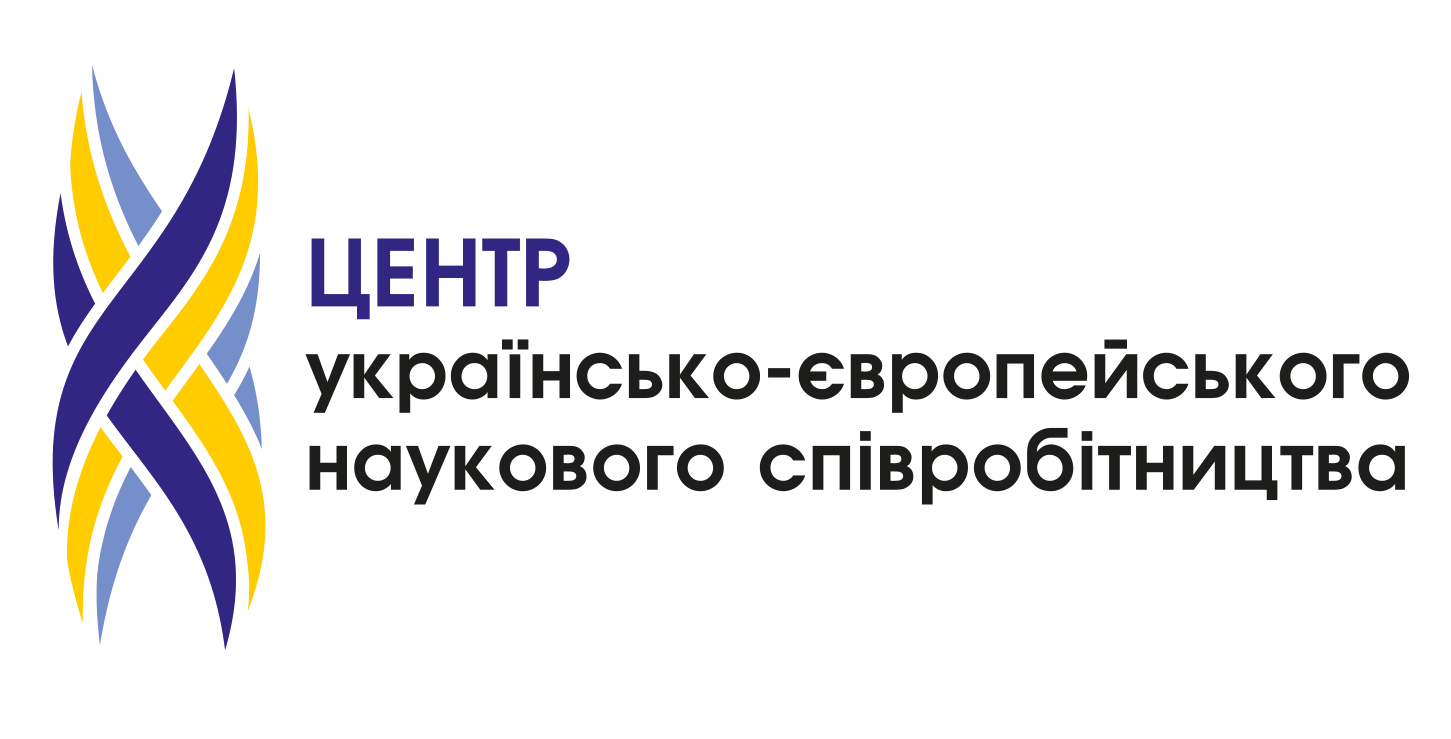 Key features of the education system
Key features of the education system
Two ministries bear the main responsibility for Luxembourg’s educational system:
- The ministry of Education, Children and Youth (MENJE; ministère de l’Éducation nationale, de l’Enfance et de la Jeunesse) is responsible for the planning and management of school education, of structures providing non-formal extracurricular education and care, and of a large part of the adult education provision and support schemes
- The ministry of Higher Education and Research (MESR; ministère de l’Enseignement supérieur et de la Recherche) is responsible for higher education.
In some fields of education and training, governance is ensured by other authorities.
- The ministry of Family Affairs, Integration and the Greater Region (MFI; ministère de la Famille, de l’Intégration et à la Grande Région) is in charge of educational provision for senior citizens and educational measures related to the integration of adult foreign citizens
- The ministry of Labour, Employment and the Social and Solidarity Economy (MTE; ministère du Travail, de l’Emploi et de l’Économie sociale et solidaire) , through its Agency for the development of employment (ADEM; Agence pour le développement de l’emploi) cooperates with the ministry of Education, Children and Youth to implement measures and training programmes for unemployed people
- Municipalities play an important role in the field of elementary education. Teachers are appointed by the State, while municipalities are competent for the organisation of elementary education, for the approval of school success schemes and for the setup of extracurricular childcare schemes (PEP; Plan d’encadrement périscolaire). Moreover, municipalities have to provide the infrastructure and educational facilities for elementary schools.
Luxembourg’s education system is shaped by the country’s political, economic, demographic and linguistic particularities, such as:
- Small territory: with a surface of 2 586 km2, Luxembourg is one of the smallest EU Member States. Despite a population growth of 68 % in the course of the past 50 years (see article 1.3 Population), the number of residents is still relatively low compared to other countries, but steadily increasing and diversifying (576 249 residents according to the 2016 census; 602 005 in January 2018). This feature has large repercussions on the country’s educational provision. The number of courses and programmes has to be streamlined and organised to attract a critical mass of learners while offering a maximum of educational choices. For this reason also, Luxembourg has developed a range of measures allowing residents to enrol in education and training in the Greater Region or in other countries abroad. A long-standing tradition of educational mobility has strongly established itself, especially in the field of higher education
- Multinational population and workforce: Luxembourg’s demographic situation is characterised by high immigration rates and a strong presence of foreigners. In 2018, according to STATEC data, 47.9 % of Luxembourg’s inhabitants, that is 288 234 people, hold a foreign nationality. The most important groups of foreign residents are Portuguese (96 544), French (45 822 ), Italian (21 962) and Belgian (20 212).
In addition to this, cross-border wage earners (158 500 in 2015) are employed on Luxembourg’s labour market, commuting from the neighbouring regions of France, Belgium and Germany (source: Greater Region statistics, 2016).
The growing cultural heterogeneity of Luxembourg’s pupil population appears in the statistics about the first language spoken at home by pupils enrolled in elementary education: in 2004/05, Luxembourgish was the language spoken at home by a majority of pupils. By 2012/13, the situation had already reversed: 60.2 % of pupils stated that their first language at home is not Luxembourgish.
As far as educational success is concerned, foreign pupils do not enjoy equal chances: although 44.1 % of all pupils entering Luxembourg’s school system are foreign nationals, they are not equally represented throughout all types of education. In 2014/15, foreigners only made up 21.6 % of all pupils enrolled in general secondary education (enseignement secondaire classique), whereas they were strongly represented (45.7 %) in technical secondary schools (enseignement secondaire général). This gap has been widening during the past decades - Multilingualism: Luxembourg is a trilingual country. The national language is Luxembourgish, the legislative language is French and the official administrative and judicial languages are French, German and Luxembourgish. Moreover, the languages spoken by immigrants (such as Portuguese and Italian), as well as English, are gaining importance.
This plurality of languages is reflected in the education system. While German is the main language of instruction at elementary school and in lower secondary education, most subjects in higher secondary education are taught in French.
As a consequence, Luxembourg has the highest share of students who do not speak the language of instruction at home. It also has the highest number of foreign languages learnt per student. The annual instruction time for foreign languages exceeds that of all other countries. Language learning plays a crucial role in school and in adult education. Likewise, the choice of the working language of an educational activity can be vital for its accessibility and for the learner’s educational success - Implication of social partners: The social dialogue between the government, professional chambers and trade unions traditionally plays an important role in Luxembourg. This is also true in the field of education. Throughout the education system, representatives of different interest groups (professional chambers, parents associations) are part of various bodies and commissions.
Stages of the education system
School attendance is compulsory between the ages of 4 and 16 years. Pupils have to attend school for at least 12 years. This period includes elementary school (école fondamentale) and secondary education (enseignement secondaire).
Elementary school comprises four learning cycles (cycles d’apprentissage):
- Cycle 1 for children from 3 to 5 years of age, including a first, optional year of early childhood education (éducation précoce) and two years of preschool education (éducation préscolaire)
- Cycle 2 for children between 6 and 7 years of age
- Cycle 3 for children between 8 and 9 years of age
- Cycle 4 for children between 10 and 11 years of age.
Secondary education comprises two branches of education (ordres d’enseignement):
- General secondary education (ESC; enseignement secondaire ‘classique’). With a standard duration of seven years, this branch prepares pupils for post-secondary education and leads to a secondary school leaving diploma (diplôme de fin d’études secondaires)
- Technical secondary education (ESG; enseignement secondaire ‘général’), divided into three regimes (régimes):
- Technical regime (régime technique) with a standard duration of eight years and leading to a technical secondary school leaving diploma (diplôme de fin d’études secondaires) which allows general access to higher education
- Technician’s regime (régime de la formation de technicien) lasting seven years and leading to a technician’s diploma (DT; diplôme de technicien) which gives access to higher technical studies
- Vocational regime (régime professionnel) lasting six years and leading either to a vocational aptitude diploma (DAP; diplôme d’aptitude profesionnelle) granting job market access as qualified worker, or to a certificate of vocational ability (CCP; certificat de capacité professionnelle).
Pupils with special needs are integrated in mainstream education as far as possible, or they may receive special education (éducation différenciée).
In recent years, the Luxembourgish education system has evolved towards a broader diversification of provision for the schooling of foreign pupils. At present, there is a variety of educational offers for pupils from different linguistic backgrounds, both at elementary and secondary school levels.
The large majority of pupils attend public schools (84.7 % in 2014/15). A small proportion of children (11.3 %) are enrolled in private schools, of which 3.8 % apply Luxembourg’s official curricula, or in private or international schools following other curricula. International schools are particularly popular in general secondary education. In 2014/15, pupils in international schools accounted for 29.9 % of the total population enrolled in general secondary education.
Higher education involves a range of bachelor and master programmes, as well as doctoral studies, offered mainly by the University of Luxembourg. In addition, secondary schools propose short-cycle programmes leading to advanced technicians diplomas (BTS; brevet de technicien supérieur). The offer is completed by other institutions providing higher education, such as professional associations, foreign universities or public research centres. Some of these institutions cooperate with foreign education providers to make other countries’ programmes accessible to students based in Luxembourg.
Post-secondary non-tertiary education mainly consists of preparatory courses for a vocational master’s qualification (brevet de maîtrise). These courses are organised by the chamber of Trades (Chambre des métiers) for artisans holding a vocational aptitude diploma or another recognised qualification. The brevet de maîtrise enables them to work as independent artisans and to train apprentices.
The educational provision in adult education includes continuing vocational training for adults to adapt and enlarge their qualifications according to skills needs; preparation classes for national diplomas and certificates; courses of general interest. Given Luxembourg’s multilingual tradition, language courses are an important part of the offer.
Structure of the national education system
Resource: https://eacea.ec.europa.eu/national-policies/eurydice/content/luxembourg_en









